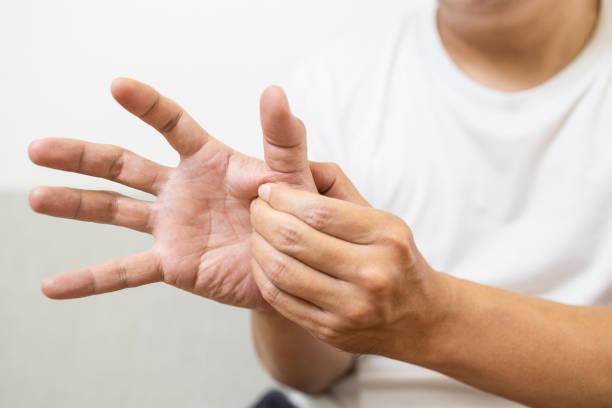De Quervain’s tenosynovitis—a condition that affects hand and wrist movement, causing pain and discomfort. In this informative post, we will explore what are the causes De Quervain’s Tenosynovitis, help you recognize its symptoms, provide home remedies and self-care techniques for pain relief, and offer tips on preventing and managing the condition in the long run.
De Quervain’s Tenosynovitis: Definition
De Quervain’s Tenosynovitis is a condition characterized by inflammation and irritation of the tendons located on the thumb side of the wrist. It specifically affects the tendons of the abductor pollicis longus and extensor pollicis brevis muscles, which are responsible for the movement of the thumb. The inflammation typically occurs within the synovial sheath, a protective covering that allows smooth tendon movement. When this sheath becomes inflamed, it can cause pain, tenderness, and swelling in the affected area. The condition is often caused by repetitive hand and wrist movements, overuse of the tendons, or direct injury. Individuals with De Quervain’s tenosynovitis may experience difficulty in performing activities that involve grasping, pinching, or twisting motions.
Causes of De Quervain’s Tenosynovitis
De Quervain’s tenosynovitis is often caused by a combination of factors related to repetitive hand and wrist movements, overuse of the tendons, and injury to the affected area. Let’s explore each of these causes in detail:
-
Repetitive Movements:
Activities such as typing, using a computer mouse, playing musical instruments, gardening, or even lifting objects with repetitive twisting motions can strain the tendons in the thumb and wrist.
-
Overuse:
This is particularly common in occupations or activities that involve repetitive gripping, pinching, or twisting motions.
-
Injury:
A direct blow to the thumb or wrist, a fall, or a sudden forceful movement that strains the tendons can lead to inflammation and subsequent pain.
Recognizing the Symptoms
-
Pain and Tenderness:
The affected area experiences localized pain and tenderness, typically along the thumb side of the wrist, which may worsen with movement or pressure.
-
Swelling and Inflammation:
Inflammation leads to visible swelling around the base of the thumb and wrist, often accompanied by warmth and redness.
-
Difficulty in Grasping or Pinching:
Individuals may have difficulty grasping or pinching objects due to the pain and limited mobility in the thumb and wrist. Simple tasks like holding a pen or turning a doorknob can become challenging.
Home Remedies and Self-Care for De Quervain’s Tenosynovitis
How to get rid of De Quervain Pain– continue reading to know more:
Rest and Relaxation Techniques: Managing pain and reducing discomfort can be achieved through proper rest and relaxation. This involves giving the affected hand and wrist ample time to recover by avoiding activities that aggravate the condition.
Finger and Thumb Exercises: Gentle stretching and strengthening exercises can improve flexibility, reduce stiffness, and promote healing. These exercises can include simple movements such as finger bends, thumb stretches, and rotational motions.
Applying Cold and Warm Compresses: Cold compresses, such as ice packs or cold gel packs, can help reduce inflammation and provide temporary pain relief. On the other hand, warm compresses, such as warm towels or heating pads, can help relax muscles, increase blood flow, and ease stiffness.
Maintaining Proper Posture: Maintaining good posture and ergonomics is essential for minimizing strain on the hand and wrist. When performing activities, such as typing or writing, it is important to sit in a comfortable and supportive position, with the wrists in a neutral position.
Additionally, for individuals seeking advanced pain relief and treatment, the innovative De Quervain’s Wand offers a portable and effective solution. The wand utilizes heat waves to target the affected area and promote healing. With the aid of the included jelly, the wand glides smoothly over the skin, enhancing comfort during the treatment process. The accompanying taping for de quervain’s tenosynovitis restricts unnecessary hand movement, providing stability and support to the affected wrist. This combination of heat therapy, ease of use, and supportive accessories makes the De Quervain’s Wand an excellent choice for individuals seeking non-surgical, at-home treatment for De Quervain’s tenosynovitis.
Frequently Asked Questions (FAQs)
Can De Quervain’s tenosynovitis be cured without surgery?
Yes, in many cases, non-surgical treatments such as rest, immobilization, and therapy can effectively manage the condition.
How long does it take to recover from De Quervain’s tenosynovitis?
The recovery time can vary depending on the severity of the condition and the individual’s response to treatment. It may take several weeks to a few months for complete recovery.
Are there any specific hand exercises that can help with De Quervain’s tenosynovitis?
Yes, finger and thumb exercises, as recommended by a healthcare professional, can improve flexibility and strengthen the affected muscles, promoting healing and reducing pain.
Can overuse of smartphones or tablets contribute to the development of De Quervain’s tenosynovitis?
Yes, repetitive use of smartphones or tablets, especially when texting or using excessive thumb movements, can strain the tendons and contribute to the development of the condition.
Is De Quervain’s tenosynovitis a chronic condition?
In some cases, the condition may become chronic if not properly managed. However, with appropriate treatment and lifestyle adjustments, most individuals can experience significant improvement and long-term management of symptoms.
